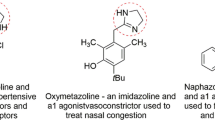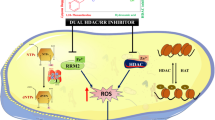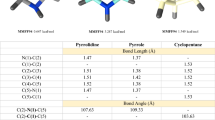Abstract
To discover new Werner (WRN) helicase inhibitors, a series of N-aryl-2-trifluoromethyl-quinazoline-4-amine derivatives were designed and synthesized through a structural optimization strategy, and the anticancer activities of 25 new target compounds against PC3, K562, and HeLa cell lines were evaluated by the MTT assay. Some of these compounds exhibited excellent inhibitory activity against three different cancer cell lines. Compounds 6a, 8i, and 13a showed better antiproliferative activity against K562 cells, with IC50 values of 3871.5, 613.6 and 134.7 nM, respectively, than did paclitaxel (35.6 nM), doxorubicin (2689.0 nM), and NSC 617145 (20.3 nM). To further verify whether the antiproliferative activity of these compounds is dependent on WRN, PC3 cells overexpressing WRN (PC3-WRN) were constructed to further study their antiproliferative potency in vitro, and the inhibition ratio and IC20 values showed that compounds 6a, 8i, and 13a were more sensitive to PC3-WRN than were the control group cells (PC3-NC). The IC20 ratios of compounds 6a, 8i, and 13a to PC3-NC and PC3-WRN were 94.3, 153.4 and 505.5, respectively. According to the docking results, the compounds 6a, 8i, and 13a overlapped well with the binding pocket of 6YHR. Further study demonstrated that among the tested compounds, 13a was the most sensitive to PC3-WRN. In summary, our research identified a series of N-aryl-2-trifluoromethyl-quinazoline-4-amine derivatives as potential WRN-dependent anticancer agents.
Graphical abstract









Similar content being viewed by others
Data availability
We have shared the link to my data at the Attach File step, named the Supporting Information.
References
Pearl LH, Schierz AC, Ward SE et al (2015) Therapeutic opportunities within the DNA damage response. Nat Rev Cancer 15:166–180. https://doi.org/10.1038/nrc3891
Tubbs A, Nussenzweig A (2017) Endogenous DNA damage as a source of genomic instability in cancer. Cell 168:644–656. https://doi.org/10.1016/j.cell.2017.01.002
Wang M, Chen S, Ao D (2021) Targeting DNA repair pathway in cancer: mechanisms and clinical application. MedComm 2:654–691. https://doi.org/10.1002/mco2.103
Laghi L, Bianchi P, Malesci A (2008) Differences and evolution of the methods for the assessment of microsatellite instability. Oncogene 27:6313–6321. https://doi.org/10.1038/onc.2008.217
Vuković Đerfi K, Salar A, Cacev T et al (2023) EMAST type of microsatellite instability-a distinct entity or blurred overlap between stable and MSI tumors. Genes (Basel) 14:1474. https://doi.org/10.3390/genes14071474
van Wietmarschen N, Sridharan S, Nathan WJ et al (2020) Repeat expansions confer WRN dependence in microsatellite-unstable cancers. Nature 586:292–298. https://doi.org/10.1038/s41586-020-2769-8
Ye T, Lin A, Qiu Z et al (2023) Microsatellite instability states serve as predictive biomarkers for tumors chemotherapy sensitivity. iScience 26:107045. https://doi.org/10.1016/j.isci.2023.107045
Saydam N, Kanagaraj R, Dietschy T et al (2007) Physical and functional interactions between Werner syndrome helicase and mismatch-repair initiation factors. Nucleic Acids Res 35:5706–5716. https://doi.org/10.1093/nar/gkm500
Datta A, Dhar S, Awate S et al (2021) Synthetic lethal interactions of RECQ helicases. Trends Cancer 7:146–161. https://doi.org/10.1016/j.trecan.2020.09.001
Chan EM, Shibue T, McFarland JM et al (2019) WRN helicase is a synthetic lethal target in microsatellite unstable cancers. Nature 568:551–556. https://doi.org/10.1038/s41586-019-1102-x
Picco G, Cattaneo CM, van Vliet EJ et al (2021) Werner helicase is a synthetic-lethal vulnerability in mismatch repair-deficient colorectal cancer refractory to targeted therapies, chemotherapy, and immunotherapy. Cancer Discov 11:1923–1937. https://doi.org/10.1158/2159-8290.CD-20-1508
Hao S, Tong J, Jha A et al (2022) Synthetical lethality of Werner helicase and mismatch repair deficiency is mediated by p53 and PUMA in colon cancer. Proc Natl Acad Sci USA 119:e2211775119. https://doi.org/10.1073/pnas.2211775119
Parker MJ, Lee H, Yao S et al (2023) Identification of 2-sulfonyl/sulfonamide pyrimidines as covalent inhibitors of WRN using a multiplexed high-throughput screening assay. Biochemistry 62:2147–2160. https://doi.org/10.1021/acs.biochem.2c00599
Aggarwal M, Banerjee T, Sommers JA et al (2013) Werner syndrome helicase has a critical role in DNA damage responses in the absence of a functional fanconi anemia pathway. Cancer Res 73:5497–5507. https://doi.org/10.1158/0008-5472.CAN-12-2975
Aggarwal M, Sommers JA, Shoemaker RH et al (2011) Inhibition of helicase activity by a small molecule impairs Werner syndrome helicase (WRN) function in the cellular response to DNA damage or replication stress. Proc Natl Acad Sci USA 108:1525–1530. https://doi.org/10.1073/pnas.1006423108
Moles R, Bai X, Chaib-Mezrag H et al (2016) WRN-targeted therapy using inhibitors NSC 19630 and NSC 617145 induce apoptosis in HTLV-1-transformed adult T-cell leukemia cells. J Hematol Oncol 9:121. https://doi.org/10.1186/s13045-016-0352-4
Sommers JA, Kulikowicz T, Croteau DL et al (2019) A high-throughput screen to identify novel small molecule inhibitors of the Werner Syndrome Helicase-Nuclease (WRN). PLoS ONE 14:e0210525. https://doi.org/10.1371/journal.pone.0210525
Auti PS, George G, Paul AT et al (2020) Recent advances in the pharmacological diversification of quinazoline/quinazolinone hybrids. RSC Adv 10:41353–41392. https://doi.org/10.1039/d0ra06642g
Bhatia P, Sharma V, Alam O et al (2020) Novel quinazoline-based EGFR kinase inhibitors: a review focussing on SAR and molecular docking studies (2015–2019). Eur J Med Chem 204:112640. https://doi.org/10.1016/j.ejmech.2020.112640
Plescia F, Maggio B, Daidone G et al (2021) 4-(3H)-quinazolinones N-3 substituted with a five membered heterocycle: a promising scaffold toward bioactive molecules. Eur J Med Chem 213:113070. https://doi.org/10.1016/j.ejmech.2020.113070
Wang X, Guan F, Ohkoshi E et al (2014) Optimization of 4-(N-cycloamino)phenylquinazolines as a novel class of tubulin-polymerization inhibitors targeting the colchicine site. J Med Chem 57:1390–1402. https://doi.org/10.1021/jm4016526
Ravez S, Castillo-Aguilera O, Depreux P et al (2015) Quinazoline derivatives as anticancer drugs: a patent review (2011-present). Expert Opin Ther Pat 25:789–804. https://doi.org/10.1517/13543776.2015.1039512
Hosomi Y, Morita S, Sugawara S et al (2020) Gefitinib alone versus Gefitinib plus chemotherapy for non-small-cell lung cancer with mutated epidermal growth factor receptor: NEJ009 study. J Clin Oncol 38:115–123. https://doi.org/10.1200/jco.19.01488
Yang Z, Hackshaw A, Feng Q et al (2017) Comparison of gefitinib, erlotinib and afatinib in non-small cell lung cancer: a meta-analysis. Int J Cancer 140:2805–2819. https://doi.org/10.1002/ijc.30691
Laskin J, Liu S, Tolba K et al (2020) NRG1 fusion-driven tumors: biology, detection, and the therapeutic role of afatinib and other ErbB-targeting agents. Ann Oncol 31:1693–1703. https://doi.org/10.1016/j.annonc.2020.08.2335
Shirley M (2018) Dacomitinib: first global approval. Drugs 78:1947–1953. https://doi.org/10.1007/s40265-018-1028-x
Manevski N, King L, Pitt W et al (2019) Metabolism by aldehyde oxidase: drug design and complementary approaches to challenges in drug discovery. J Med Chem 62:10955–10994. https://doi.org/10.1021/acs.jmedchem.9b00875
Liu K, Mo M, Yu G et al (2023) Discovery of novel 2-(trifluoromethyl)quinolin-4-amine derivatives as potent anticancer agents with microtubule polymerization inhibitory activity. Bioorg Chem 139:106727. https://doi.org/10.1016/j.bioorg.2023.106727
Jin X, Wang S, Zhao LM et al (2023) Development of fluorine-substituted NH2-biphenyl-diarylpyrimidines as highly potent non-nucleoside reverse transcriptase inhibitors: boosting the safety and metabolic stability. Acta Pharm Sin B 13:1192–1203. https://doi.org/10.1016/j.apsb.2022.08.017
Johnson BM, Shu Y, Zhuo X et al (2020) Metabolic and pharmaceutical aspects of fluorinated compounds. J Med Chem 63:6315–6386. https://doi.org/10.1021/acs.jmedchem.9b01877
Jayanetti K, Takemura K, Bendale H et al (2023) Recent advances in the strategic incorporation of fluorine into new-generation taxoid anticancer agents☆. J Fluorine Chem 267:110106. https://doi.org/10.1016/j.jfluchem.2023.110106
Oguz M (2022) Synthesis and anticancer activity of new p-tertbutylcalix[4]arenes integrated with trifluoromethyl aniline groups against several cell lines. Tetrahedron 116:132816. https://doi.org/10.1016/j.tet.2022.132816
Meanwell NA (2018) Fluorine and fluorinated motifs in the design and application of bioisosteres for drug design. J Med Chem 61:5822–5880. https://doi.org/10.1021/acs.jmedchem.7b01788
Dolšak A, Švajger U, Lešnik S et al (2019) Selective Toll-like receptor 7 agonists with novel chromeno[3,4-d]imidazol-4(1H)-one and 2-(trifluoromethyl)quinoline/quinazoline-4-amine scaffolds. Eur J Med Chem 179:109–122. https://doi.org/10.1016/j.ejmech.2019.06.030
Funding
This work was supported by the National Natural Science Foundations of China (82260675), the Department of Science and Technology of Guizhou Province (No. QKHPTRC[2016]5678, No. QKHZYD[2022]4015), and the Natural Science Foundation of Guizhou Province (No. QKHJC-ZK[2021]YB07, No. QKHJC-ZK[2022]ZD031). The Science and Technology Planning Project of Guizhou Province (No. QKHZC [2023]YB241, No. QKHZC [2020]4Y161), the Guizhou Province “Hundred” Level Innovative Talent Training Project (No. QKHPTRC-GCC [2022]034-1), and the Natural Science Foundation of Guizhou Medical University (No. 21NSFCP42, No. 22NSFCP24) were used.
Author information
Authors and Affiliations
Contributions
The manuscript was written by the contributions of all authors, and all authors have approved the final version of the manuscript.
Corresponding authors
Ethics declarations
Conflict of interests
The authors declare that they have no known competing financial interests or personal relationships that could have appeared to influence the work reported in this paper.
Additional information
Publisher's Note
Springer Nature remains neutral with regard to jurisdictional claims in published maps and institutional affiliations.
Supplementary Information
Below is the link to the electronic supplementary material.
Rights and permissions
Springer Nature or its licensor (e.g. a society or other partner) holds exclusive rights to this article under a publishing agreement with the author(s) or other rightsholder(s); author self-archiving of the accepted manuscript version of this article is solely governed by the terms of such publishing agreement and applicable law.
About this article
Cite this article
Li, H., Yu, J., Yu, G. et al. Design and synthesis of N-aryl-2-trifluoromethyl-quinazoline-4-amine derivatives as potential Werner-dependent antiproliferative agents. Mol Divers (2024). https://doi.org/10.1007/s11030-024-10844-6
Received:
Accepted:
Published:
DOI: https://doi.org/10.1007/s11030-024-10844-6




